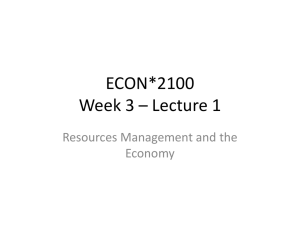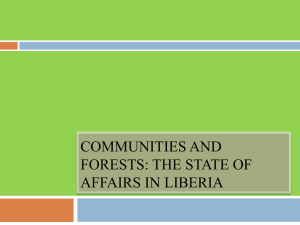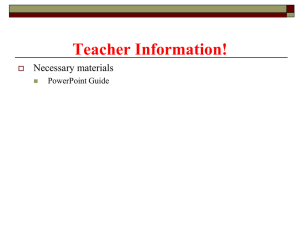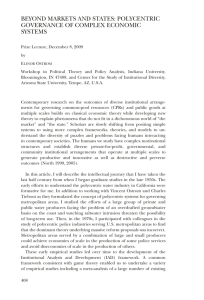Slide 6
advertisement
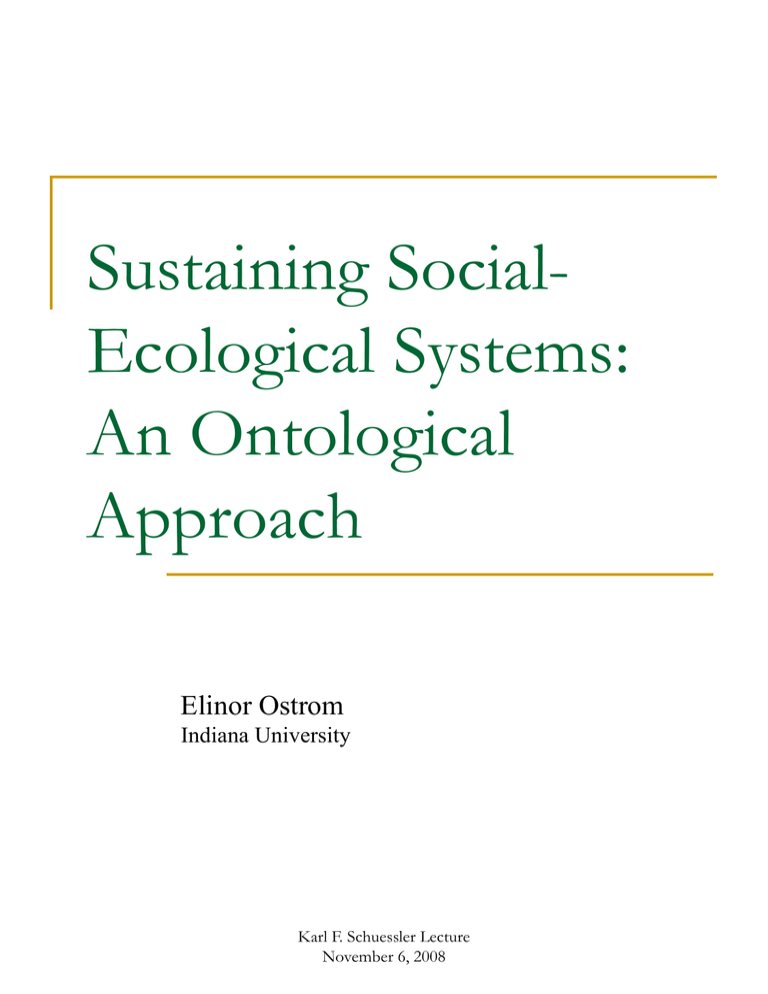
Sustaining SocialEcological Systems: An Ontological Approach Elinor Ostrom Indiana University Karl F. Schuessler Lecture November 6, 2008 Sustaining Social-Ecological Systems is a Struggle A central theme of this talk is SocialEcological Systems are complex. Understanding SES’s is a challenge -BUT IT IS WORTH IT! Without understanding, we can recommend policies that may things worse rather than better Two tasks for today A brief overview of recent research that draws on both ecological and social sciences A brief overview of a new framework that may help us to integrate our research by providing a common tiered language Diversity is Important for Sustainability Two types: Simple institutional solutions are frequently recommended as universal panaceas Biological diversity – extensive scientific findings – well accepted Institutional diversity – importance not yet accepted Government ownership Privatize land Co-management Imposing simple policy blueprints reduces institutional diversity and ecological sustainability Our research finds variations of all 3 succeed & fail Lets review findings from our multi-country, multidisciplinary forestry research network using remote sensing & field studies. First to Maya Biosphere Reserve in Guatemala Maya Biosphere Reserve Multitemporal Color Composite (Dietz, Ostrom, Stern, 2003, Science SOM) clouds A El MiradorRio Azul NP Laguna del Tigre Biotope Laguna del Tigre NP Multiple Use Zone NaachtunDos Lagunas Biotope El Zotz Biotope Tikal NP D B Buffer Zone Sierra del Lacandón NP C 0 B C D 10 20 km N Maya Biosphere Reserve Four National Parks (NPs) in close proximity Tikal NP has large budget to pay for extensive fences and guards El Mirador protected by nature Laguna del Tigre severely overharvested Sierra del Lacandón severely overharvested Same formal institution: Two are sustainable, but different causal process Two are vulnerable to massive illegal harvesting Now to Uganda An example of sustainable Government Forest Reserves West Mengo region located in earlier Buganda kingdom In early 1900s, tough negotiations to settle private land and set up reserves in 1930s Local forest users use NTFP and participate every two decades in boundary demarcation Users value the forest and know the boundaries Very stable from 1936 to 2000 Recent decentralization is disrupting this stability Uganda Forest Reserves Islands 0 2.5 5 km N Now to India Todoba-Andhari Tiger Reserve An under-funded national wildlife reserve with multiple outcomes Stable forests in the core Park guards are not able to control harvesting along sections of the borders Complementary field studies find Consistent harvesting of nontimber forest products Existence of considerable conflict between guards and local people Nagendra & Ostrom, PNAS, 2006 Clearing Regrowth Stable forest Clearing TADOBAANDHARI TIGER RESERVE Regrowth Interior villages Multi-temporal Landsat color composite, 1972-19892001, landscape surrounding Tadoba-Andhari Tiger Reserve, India. Women harvesting thatch grass from within the TATR - while the forest ranger accompanying our research team looks on helplessly. Cattle entering the TATR boundary (marked by the yellow topped pillar in the background) on their daily foraging beat. Bicycles and trucks confiscated from timber poachers stealing large logs Are Protected Areas the “Only Way” to Sustain Forests? While some Protected Parks are successful in protecting forests, others are not. Depends on many factors In a large cross-sectional IFRI study of 163 forests in 12 countries, no difference in forest density (scale assigned by forester on team after doing forest plots) is measured for Protected Parks compared to all other institutional arrangements (Non-Parks) Comparison of Forester’s Field Evaluation of Vegetation Densities in 163 Parks and Non-Parks Vegetation density Officially designated parks Very sparse Sparse About average Somewh at abundant Very abundant 13% 21% 36% 26% 4% 6% 22% 43% 26% 3% (N = 76) Non-parks (N = 87) Kolmogorov-Smirnov Z score = 0.472, p = .979. No significant difference. Source: Hayes, Tanya, & Elinor Ostrom, “Conserving the World’s Forests: Are Protected Areas the Only Way?” Indiana Law Review 38(3) (2005): 607. Findings from Repeat Visits to IFRI Forests 2nd time research visit in 42 IFRI forests India – 5 forests Kenya – 3 forests Nepal – 10 forests Uganda – 18 forests USA – 6 forests Not a random sample of forests but based on a random sample of plots inside each forest and first study of this type Can now assess: Relative strength of formal institution on changes in DBH, basal area, and stem count Strength of regular involvement of user groups in monitoring forests on same forest measures Impact of Formally Designated Tenure and Forest Monitoring on Changes in Forest Condition: Assessment using ANOVA Independent variables Change in DBH Change in basal area Change in stem count Ownershipa F = 0.89 F = 2.52 F = 1.00 F = 0.28 F = 10.55** F = 4.66* Involvement of user groups in monitoring rulesb a Government, community, private b At least one user group is involved in regular monitoring of rules of forest use * Significant at .05 ** Significant at .01 Source: Ostrom, Elinor, & Harini Nagendra, “Insights on Linking Forests, Trees, and People from the Air, on the Ground, and in the Laboratory.” PNAS 103(51) (2006): 19230. A Puzzle from Field Research: Why Do Users Monitor Others? Voluntary effort to produce a “public good” of rule conformance Game theoretic predictions – no one will voluntarily contribute to provide a public good Earlier findings from field studies led to a series of laboratory experiments at IU and now replicated by others Harvesting Common-Pool Resources in the Lab Baseline experiment of complete anonymity and finitely repeated game Game theoretical prediction is substantial over-harvesting Prediction supported in the lab Adding the capacity to communicate – does not change prediction – in a social dilemma communication is only CHEAP TALK Subjects make good use of opportunity for cheap talk – especially when repeated They use it to agree on joint harvesting strategy & for verbal sanctions of unknown over-harvesters Aggregate Results of CPR Experiments Experimental Designs using 25 Token Endowments Average Net Yield as % of Maximuma Average Net Yield Defection Minus Fees & Rate Fines (%) (A) Baseline Experiment: No Communication (3) 21 - - (B) One-shot Communication (3) 55 - 25 (C) Repeated Communication (6) 73 - 13 (D) Imposed Sanctioning Institution (8) _ 37 9 85 67 1 (F1) One-shot Communication Endogenous Choice of Sanctioning Institution None Chosen (2) 56 - 42 (F2) One-shot Communication Endogenous Choice of Sanctioning Institution – Sanction Chosen (4) 93 90 4 (E) One-shot Communication & Imposed Sanctioning Institution (3) aNash equilibrium for all designs is a net yield of 39% of maximum (Adapted from: Ostrom, Walker, and Gardner, 1992: p. 414) What Have We Learned? No single idealized type of governance structures is successful in all ecological and social settings We should NOT eliminate institutional diversity to save biodiversity Danger of Institutional Monoculture Abstract concepts – government ownership, co-management Tend to impose uniform rules People living in or around forest frequently not involved in design Few opportunities for experimentation and learning Rules-on-paper confused for rulesin-use – don’t really know what rules are being used in field Self Governance is Feasible Resources & human uses can be monitored & the info verified & understood at relatively low cost (trees easier to monitor than fish) WHEN Rates of change in key variables are moderate Communities do have thick networks of social capital Excluding outsiders is relatively low costs Users consider rules legitimate & support monitoring and sanctioning activities The Challenges Ahead Need further investment in understanding complex socialecological systems (SESs) Developed a multi-tier, multidisciplinary ontology for analyzing SES’s For a Special Feature of PNAS September 2007 A core set of 4 variable clusters at a focal level that together generate interactions and outcomes Affected by, and affect larger and smaller ecosystems as well as social, economic, and political systems Let’s look at the first tier A Multitier Framework for Analyzing Sustainable Social-Ecological Systems Social, Economic, and Political Settings (S) Resource System (RS) Governance System (GS) Interactions (I) → Outcomes (O) Resource Units (RU) Direct causal link Users (U) Feedback Related Ecosystems (ECO) To Analyze Sustainable or Unsustainable Interactions and Outcomes Need to dig down one or two tiers for several of main first tier variables Lets dig down one level to an initial listing of 2nd tier variables But – when you see 50 + variables at second level – do not panic! Need to identify which second-tier (and potentially 3rd or 4th tier) variables are relevant to a particular question being examined All 2nd (3rd or 4th) tier variables are not relevant for every theoretical or empirical study Social, Economic, and Political Settings (S) S1- Economic development. S2- Demographic trends. S3- Political stability. S4- Government settlement policies. S5- Market incentives. S6-Media organization Resource System (RS) RS1fish) RS2RS3RS4RS5RS6RS7RS8RS9- Governance System (GS) Sector (e.g., water, forests, pasture, Clarity of system boundaries Size of resource system Human-constructed facilities Productivity of system Equilibrium properties Predictability of system dynamics Storage characteristics Location Resource Units (RU) RU1RU2RU3RU4RU5RU6RU7- GS1- Government organizations GS2- Non-government organizations GS3- Network structure GS4- Property-rights systems GS5- Operational rules GS6- Collective-choice rules GS7- Constitutional rules GS8- Monitoring and sanctioning processes Users (U) Resource unit mobility Growth or replacement rate Interaction among resource units Economic value Size Distinctive markings Spatial and temporal distribution U1U2U3U4U5U6U7U8U9- Number of users Socioeconomic attributes of users History of use Location Leadership/entrepreneurship Norms/social capital Knowledge of SES/mental models Dependence on resource Technology used Interactions (I) - Outcomes (O) I1I2I3I4I5I6- Harvesting levels of diverse users Information sharing among users Deliberation processes Conflicts among users Investment activities Lobbying activities O1- Social performance measures (e.g., efficiency, equity, accountability) O2- Ecological performance measures (e.g., overharvested, resilience, diversity) O3- Externalities to other SESs Related Ecosystems (ECO) ECO1- Climate patterns. ECO2- Pollution patterns. ECO3- Flows into and out of focal SES. Building Theories Based on this Framework to Address 3 Broad Questions First question: What patterns of interactions and outcomes -- overuse, conflict, collapse, stability -- are likely to result from using one set of rules for the governance and use of a particular resource system and its units in a socioeconomic and political environment? In other words – which rules generate sustainable outcomes for particular types of resources? Why were the rules related to forest reserves in Uganda sustainable for many decades and recent changes now leading to deforestation Hardin did not consider any rules in his analysis Social, Economic, and Political Settings (S) S1 S2 S3- S4- S5- Market Incentives S6 Resource System (RS) Governance System (GS) GS1GS2GS3GS4GS5GS6GS7GS8- RS1- Sector – pasture RS2RS3- Finite size RS4RS5- Renewable resource RS6RS7RS8RS9- Resource Units (RU) Users (U) RU1- Mobile animals on stationary grasses RU2RU3RU4- Fattened cattle can be sold for cash RU5RU6- Distinctive markings RU7- U1- Large number of users U2U3U4U5U6U7- Maximization of short term gains for self U8U9- Interactions (I) → Outcomes (O) I1- Maximum harvesting levels of diverse users I2I3I4I5I6- O1O2- Destruction of ecological system O3- Related Ecosystems (ECO) ECO1- ECO2- ECO3- Second Type of Question For a particular resource in a particular setting, what is the likely endogenous development of different forms of governance, use patterns, and outcomes with or without external imposed rules or financing? In other words – do national governments need to impose institutions from the outside? Or, are well tailored rules likely to evolve from within in this type of setting? May need 3rd or 4th tier variables to build theory to answer this type of question Third Type of Question How robust and sustainable is a particular type of configuration of users, resource system, resource units, and governance system to external and internal disturbances? In other words – what kind of disturbances are likely to lead reduce the resilience of a particular cluster of SES variables? Population change? global warming? changes in prices? All 3 questions need theoretical development and empirical testing by multi-disciplinary research teams We all need to work on the challenge of developing this multitier framework and related theories and the empirical work to test our theoretical predictions Questions that We Can Discuss Now?

